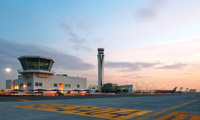Special Report: Asia-Pacific Airports Update
Middle East's lofty ambitions keeping up with the neighbours
Asia-Pacific airports are spending billions on upgrades, but their Middle East counterparts are matching them dollar for dollar as they strive to cement their position as a global crossroad for air traffic.
November 1st 2013
The world’s biggest greenfield airport development, the Al Maktoum International Airport (AMIA) at Dubai, is open for passenger business. After a day-long trial involving 1,200 Dubai residents, on October 28 it welcomed its first customer, Wizz Air, the largest low-cost carrier in Central and Eastern Europe.Read More »
Freighter services have been using the airport since 2010. The airport is part of the ambitious $33 billion Dubai World Centre, designed as an integrated city combining aviation, tourism and logistics. When completed, the airport will handle 160 million passengers a year.
 |
| The AMIA in Dubai: six concourses, two terminals and five parallel runways |
And it isn’t Dubai’s only airport. The existing Dubai International is undergoing the fourth phase of an expansion costing $7.6 billion, to raise passenger capacity from 70 million to 90 million by 2017, eventually giving Dubai a total capacity of 250 million passengers a year.
The figures are mind-numbing. AMIA will have six concourses, two terminals and five parallel runways. Put in perspective, the world’s top five airports each handle between 65 and 95 million passengers a year. Dubai International Airport last year handled 57 million passengers and is poised to cross the 64 million figure this year.
And Dubai isn’t alone in reporting strong growth. Passenger traffic at nearby Abu Dhabi International Airport in August was up 18.5% on the same period a year earlier.
Even cargo growth has been spectacular in a market where freight performance worldwide has been flat. Abu Dhabi carried 29.9% more freight in August compared with a year earlier.
Overall, Gulf states have already committed $50 billion towards specific airport expansion projects. Here are some of the major ones:
Dubai International Airport: Phase IV Development costing $7.8 billion. Work in progress on a new concourse, cargo facility and other infrastructure.
Al Maktoum International Airport: Work costing $8 billion, but the overall long-term cost of the project is much higher.
Abu Dhabi International Airport: up to $6.8 billion is being spent on a new Midfield Terminal, scheduled to open in early 2015 to handle 50 million passengers.
New Doha International Airport is being built at a cost of $11 billion. Completion is expected in 2015. It will handle 50 million passengers.
Qatar is investing $11.2 billion in developing its new hub airport.
Elsewhere, Saudi Arabia is spending heavily in expanding several of its airports.
Other big airport developments in the region include King Abdulaziz International Airport Development Phase 1 in Jeddah with an investment equivalent to $1.5 billion; expansion of Muscat International Airport estimated at $1.2 billion; approximately $2.1 billion in Kuwait International Airport and $335 million in Bahrain airport.